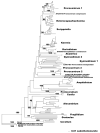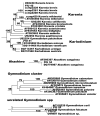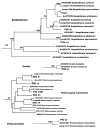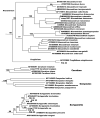Multiple simultaneous detection of Harmful Algal Blooms (HABs) through a high throughput bead array technology, with potential use in phytoplankton community analysis
- PMID: 20046212
- PMCID: PMC2615561
- DOI: 10.1016/j.hal.2008.05.003
Multiple simultaneous detection of Harmful Algal Blooms (HABs) through a high throughput bead array technology, with potential use in phytoplankton community analysis
Abstract
As an alternative to traditional, morphology-based methods, molecular techniques can provide detection of multiple species within the HAB community and, more widely, the phytoplankton community in a rapid, accurate and simultaneous qualitative analysis. These methods require detailed knowledge of the molecular diversity within taxa in order to design efficient specific primers and specific probes able to avoid cross-reaction with non-target sequences. Isolates from Florida coastal communities were sequence-analyzed and compared with the GenBank database. Almost 44% of the genotypes obtained did not match any sequence in GenBank, showing the existence of a large and still unexplored biodiversity among taxa. Based on these results and on the GenBank database, we designed 14 species-specific probes and 4 sets of specific primers. Multiple simultaneous detection was achieved with a bead array method based on the use of a flow cytometer and color-coded microspheres, which are conjugated to the developed probes. Following a parallel double PCR amplification, which employed universal primers in a singleplex reaction and a set of species-specific primers in multiplex, detection was performed in a cost effective and highly specific analysis. This multi-format assay, which required less than 4 h to complete from sample collection, can be expanded according to need. Up to 100 different species can be identified simultaneously in a single sample, which allows for additional use of this method in community analyses extended to all phytoplankton species. Our initial field trials, which were based on the 14 species-specific probes, showed the co-existence and dominance of two or more species of Karenia during toxic blooms in Florida waters.
Figures













Similar articles
-
Diversity and Distribution of Harmful Algal Bloom Species from Seamount to Coastal Waters in the South China Sea.Microbiol Spectr. 2023 Feb 23;11(2):e0416922. doi: 10.1128/spectrum.04169-22. Online ahead of print. Microbiol Spectr. 2023. PMID: 36815795 Free PMC article.
-
Fiber-optic microarray for simultaneous detection of multiple harmful algal bloom species.Appl Environ Microbiol. 2006 Sep;72(9):5742-9. doi: 10.1128/AEM.00332-06. Appl Environ Microbiol. 2006. PMID: 16957189 Free PMC article.
-
Development of a multiplex real-time qPCR assay for simultaneous enumeration of up to four marine toxic bloom-forming microalgal species.Harmful Algae. 2015 Sep;48:37-43. doi: 10.1016/j.hal.2015.06.009. Epub 2015 Jul 20. Harmful Algae. 2015. PMID: 29724474
-
Marine harmful algal blooms (HABs) in the United States: History, current status and future trends.Harmful Algae. 2021 Feb;102:101975. doi: 10.1016/j.hal.2021.101975. Epub 2021 Mar 3. Harmful Algae. 2021. PMID: 33875183 Free PMC article. Review.
-
Monitoring, modeling and projection of harmful algal blooms in China.Harmful Algae. 2022 Jan;111:102164. doi: 10.1016/j.hal.2021.102164. Epub 2021 Dec 22. Harmful Algae. 2022. PMID: 35016768 Review.
Cited by
-
Parallel detection of harmful algae using reverse transcription polymerase chain reaction labeling coupled with membrane-based DNA array.Environ Sci Pollut Res Int. 2014 Mar;21(6):4565-75. doi: 10.1007/s11356-013-2416-0. Epub 2013 Dec 13. Environ Sci Pollut Res Int. 2014. PMID: 24338073
-
Molecular Techniques for the Detection of Organisms in Aquatic Environments, with Emphasis on Harmful Algal Bloom Species.Sensors (Basel). 2017 May 22;17(5):1184. doi: 10.3390/s17051184. Sensors (Basel). 2017. PMID: 28531156 Free PMC article. Review.
-
Molecular detection, quantification, and diversity evaluation of microalgae.Mar Biotechnol (NY). 2012 Apr;14(2):129-42. doi: 10.1007/s10126-011-9427-y. Epub 2011 Dec 28. Mar Biotechnol (NY). 2012. PMID: 22200918 Review.
-
KARENIA: The biology and ecology of a toxic genus.Harmful Algae. 2012 Feb;14:156-178. doi: 10.1016/j.hal.2011.10.020. Epub 2011 Oct 25. Harmful Algae. 2012. PMID: 36733478 Free PMC article.
-
Flow Cytometry with Anti-Diffraction Light Sheet (ADLS) by Spatial Light Modulation.Micromachines (Basel). 2023 Mar 19;14(3):679. doi: 10.3390/mi14030679. Micromachines (Basel). 2023. PMID: 36985086 Free PMC article.
References
-
- Adachi M, Sako Y, Ishida Y. Restriction fragment length polymorphism of ribosomal DNA Internal Transcribed Spacer and 5.8S region in Japanese Alexandrium species (Dinophyceae) J Phycol. 1994;30:857–863.
-
- Balech E. El genero Protoperidinium, Bergh 1881 (Peridinium, Ehrenberg 1831, partim) Revista del Museo Argentino de Ciencias Naturales “Bernardino Rivadavia” Hidrobiologia. 1974;4:1–79.
-
- Balech E. Cuatro especies de Gonyaulax sensu lato, y cosideraciones sobre el genero (Dinoflagellata) Revista del Museo Argentino de Ciencias Naturales “Bernardino Rivadavia” Hidrobiologia. 1977;5:115–143.
-
- Balech E. Redescription of Alexandrium minutum (Dynophyceae) type species of the genus Alexandrium. Phycologia. 1989;28:206–211.
-
- Botes L, Sym SD, Pitcher GC. Karenia cristata sp. nov. and Karenia bicuneiformis sp. nov. (Gymnodiniales, Dinophyceae): two new species from South African coast. Phycologia. 2003;42:563–571.
Grants and funding
LinkOut - more resources
Full Text Sources
Molecular Biology Databases
Research Materials

